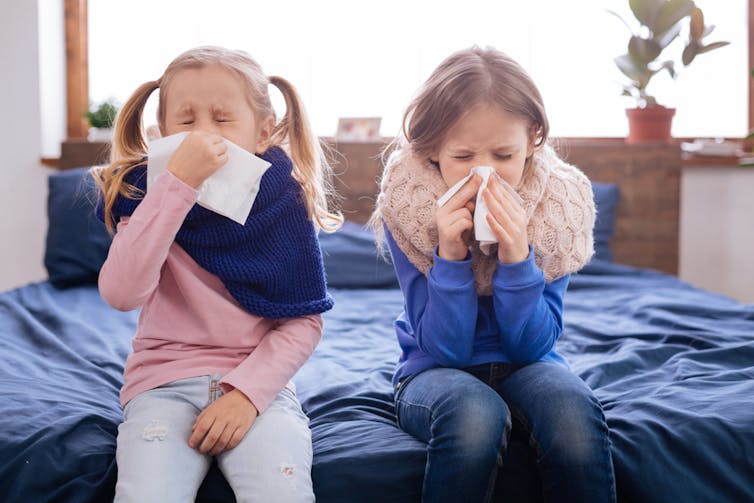
Having young children in your home may lower your risk of being hospitalised with COVID-19, according to a new study of NHS workers in Scotland.
Children often catch coughs and colds, and this includes seasonal coronaviruses that cause the common cold. Being of the same virus family, many have assumed the immune response to these common cold coronaviruses may provide some protection from COVID-19. Previous studies, however, have shown that the immune response to seasonal coronaviruses doesn’t last long and that reinfections are common.
The latest study, which has yet to be peer-reviewed, found that adults in households with young children (aged up to 11 years) had a modestly reduced risk of catching SARS-CoV-2 (the coronavirus that causes COVID-19) and a reduced risk of hospitalisation. But adults in households with children aged 12 and older had no reduction in risk compared with adults living without children.
It is important to note that children can be infected with COVID-19, and those that show symptoms are just as infectious as adults. Anyone concerned about their child being potentially infectious should follow their local government guidelines.
Several limitations
But there are several important considerations with this study that suggest these findings should be treated with caution.
Several limitations are highlighted by the authors, such as the fact that adults without children were older on average and more likely to have existing health problems when compared with those in a household with children. It is well established that age and other illnesses, such as diabetes and kidney disease, can be a big factor in how severely ill a person with COVID-19 becomes. The authors acknowledge this. And when taking these factors into account in their statistical model, the child-induced reduced risk effect was diminished – although the risk was still slightly lower than that of adults living without children.
Other factors that need to be considered include the fact that adults with children are more likely to work part-time or reduced hours due to childcare, and this may limit their exposure to COVID-19 through their work. Although the authors took this into consideration when performing their analysis, they concede that they did not have accurate data on the hours worked by the cohort during the study period.
The authors say that if exposure to cold-causing viruses is an important mechanism for protection, childcare providers and teachers might benefit from this exposure. However, before this study is taken as evidence to justify keeping schools open, it should be noted that a big limitation is the period in which data was collected. Data of COVID-19 infections and hospitalisations included for this study were collected between March 1 and July 7, 2020, a time during schools were largely closed.
Although many schools were still available for the children of essential workers during the UK lockdown, data to reflect this was not available for this study. So it is impossible to know how many households included in this study had children regularly attending school, or isolating at home, which would affect the households’ potential exposure to COVID-19.
Finally, as the authors rightly point out in their conclusion, despite finding a link between young children in a household and an apparent reduced risk of SARS-CoV-2 infections for the adults, there is no proven mechanism for why this is happening. Many have hypothesised that those exposed to seasonal coronaviruses may have some level of immunity against COVID-19, through something called “cross-protection”, this is yet to be proved.

Yakobchuk Viacheslav/Shutterstock
It is always important to remember that correlation does not mean causation – or, as the authors put it, “the observed inverse association may be a chance finding”. It will be interesting to see whether further investigation results in this finding being observed in other populations and whether the cause of this perceived reduced infection risk is determined. Until that link is found, however, this study should be taken with a pinch of salt.
![]()
Grace C Roberts works at Queen's University, Belfast and receives funding from The Wellcome Trust.

